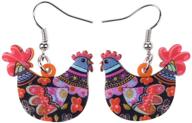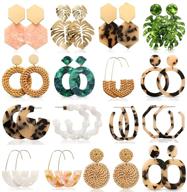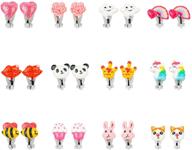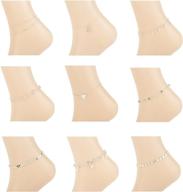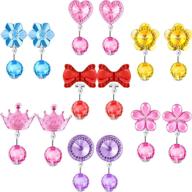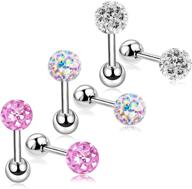Similar products
How to wear cartilage earrings without irritation?
Cartilage piercings have become increasingly popular in recent years. However, they can often become irritated, especially when you first get them pierced. Here are some tips to help prevent irritation when wearing cartilage earrings:
Choose the right earring material
- Opt for hypoallergenic metals like titanium or niobium.
- Avoid nickel or cheap metals that can cause reactions.
- Sterling silver is usually fine for healed piercings.
Keep the piercing clean
Clean the piercing 2 times per day by:
- Gently washing with antibacterial soap and water.
- Rinsing well in the shower to remove soap residue.
- Using a saline spray or sea salt soaks.
Avoid irritation
When selecting earrings:
- Choose lightweight, comfortable earrings that won't snag.
- Make sure the gauge matches your piercing.
- Avoid oversized earrings that put pressure on the piercing.
Finally, don't sleep on fresh piercings and avoid touching them. Follow these tips and your cartilage piercing should heal well with minimal irritation.
Top products in 💎 Girls' Earrings
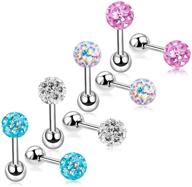

52 Review

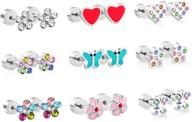

50 Review

How to Clean Sterling Silver Hoop Earrings?
Sterling silver is a beautiful metal for jewelry, but it does require some maintenance to keep it looking shiny and prevent tarnish. Cleaning sterling silver hoops properly will help remove dirt, oil, and oxidation.
Supplies Needed
- Mild dish soap
- Soft toothbrush
- Bowl of warm water
- Soft, lint-free cloth
- Silver-polishing cloth or anti-tarnish strips
Cleaning Steps
- Remove the earrings and disassemble any parts. Place in the bowl of warm, soapy water.
- Gently scrub the earring posts and hoops with the toothbrush, focusing on crevices and engraved areas.
- Rinse all soap residue off with clean water and pat dry with the soft cloth.
- Shine the earrings with a silver polishing cloth or use an anti-tarnish strip if tarnish is present.
- For stubborn tarnish, you can also use a silver dip or sponge with a jewelry cleaning solution.
- Rinse again after polishing and thoroughly dry all surfaces.
Be careful not to bend or warp the shape of the hoops when cleaning. Store them in an airtight container to prevent new tarnish between wears.
Regular gentle cleaning and polishing helps keep sterling silver hoops looking like new. Avoid using harsh chemicals or abrasives that could damage the finish.
How to Style Small Hoop Earrings?
Small hoop earrings are a versatile jewelry staple that can be dressed up or down. Here are some tips for styling this classic accessory:
Casual Looks
- Pair mini hoops with jeans and a t-shirt or tank for an effortless look.
- Add some shine to athleisure by wearing with yoga pants and a hoodie.
- Let small hoops peek out from under a beanie or ballcap.
Going Out
- Complement a little black dress or jumpsuit with shiny hoops.
- Make a maxi skirt and cropped blouse night-out ready with hoop earrings.
- Add some subtle glam to an LBD by wearing your hair up and showing off hoops.
Work Looks
- Pair with a blouse, trousers and blazer for polished office style.
- Add sparkle to a shift dress for an understated work-appropriate look.
- Choose hoops with gem accents to elevate a professional outfit.
tips
- Go for hammered gold or silver hoops for texture.
- Try hoops with chain connectors for an edgy vibe.
- Stack small hoops with studs in the same ear for interest.
The simplicity of small hoop earrings makes them easy to dress up or down. Have fun styling this must-have accessory!
How to Match Different Earrings?
Mixing and matching earrings is a fun way to express your personal style. Here are some tips for coordinating different pairs:
Match Metals
- Wearing earrings of the same metal, like all gold or silver, ties the look together.
- Complementary metals like gold and silver can work too.
- Just avoid mixing more than 3 metals to avoid looking mismatched.
Coordinate Colors
- Choose earrings in the same color family, like both blue or both neutral.
- Make one earring a pop of color and the other a metallic or neutral.
- Match the colors to the outfit you are wearing.
Consistent Size
- Petite earrings tend to mix well, while very large and very small can clash.
- Try pairing a medium and small earring, or two medium.
- Keep the size difference minimal for balance.
Complimentary Style
- A stud paired with a hoop or linear earring works nicely.
- Combine smooth and textured looks, like hammered with gemstones.
- Make sure both earrings coordinate with your personal style.
Don't be afraid to experiment until you find a mismatched pair you love. The most important tip is to choose earrings that make you feel confident and chic!
How to Insert Hoop Earrings Yourself?
Putting in hoop earrings can be tricky, but gets easier with some practice. Here are some step-by-step tips for inserting hoop earrings yourself:
Prep The Earring
- Make sure the earring and your ears are clean.
- Unclasp the hoop and remove any butterfly backings.
- Hold the hoop in your dominant hand with the opening facing up.
Insert The Front
- Use your other hand to lift the top part of your ear up.
- Gently insert the front (bottom) of the hoop into the piercing hole.
- Let your earlobe close around the front of the hoop.
Push Through The Back
- Keep a firm grip on the front of the hoop.
- Carefully push the back of the hoop all the way through the piercing.
- Avoid tugging or forcing it through if there's resistance.
Secure The Earring
- Once through, release your ear and lock the earring clasps together.
- Give the hoop a gentle squeeze so it sits snugly in place.
- Repeat the process on your other ear.
With some practice, you'll be able to smoothly insert hoop earrings in seconds. Just be patient and gentle until you get the hang of it.
How To Choose The Right Size For Your Cartilage Hoop Earrings?
Choosing the right size for your cartilage hoop earrings is crucial to ensure a comfortable fit and avoid irritation. Here are some tips to help you choose the right size:
What Is The Difference Between Gauge And Diameter When Choosing Cartilage Hoop Earrings?
When choosing cartilage hoop earrings, it's important to understand the difference between gauge and diameter. Gauge size refers to the thickness of the earring post that goes through your ear, while diameter measures the distance between the two internal sides of the hoop. Cartilage hoop gauge varies from 16g to 20g, depending on the location you want to put in. The diameter you need will depend on your ear anatomy and the location of the piercing. Different cartilage piercings require different sizes, and some jewelry needs to be longer to account for initial swelling. Keep in mind that everyone's ear is different, and your piercer may use a different sized needle depending on your exact ear size and shape, and your lifestyle. It's important to measure the distance between your ear hole and the outer edge of your ear to choose the right size of cartilage hoop earrings.
Another interesting products
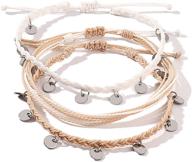

40 Review



16 Review

What Is The Standard Gauge Size For Cartilage Hoop Earrings?
The standard gauge size for cartilage hoop earrings varies depending on the location of the piercing. The most common gauge size for cartilage piercings, including the tragus, helix, rook, conch, and daith, is 16G. However, some cartilage piercings can be done with 18G or 20G. It's important to note that everyone's ear is different, and your piercer may use a different sized needle depending on your exact ear size and shape, and your lifestyle. It's recommended to measure the distance between your ear hole and the outer edge of your ear to choose the right size of cartilage hoop earrings.
What Is The Difference Between 16G And 18G Cartilage Hoop Earrings?
The difference between 16G and 18G cartilage hoop earrings lies in their thickness. The standard gauge size for most cartilage piercings, including the tragus, helix, rook, conch, and daith, is 16G. However, an 18G needle can also be used for some cartilage piercings, such as the forward helix. 18G earrings are slightly thinner than 16G earrings, with a difference of approximately 0.2mm. 18G earrings are great for many healed cartilage piercings and are less likely to close up if you take them out for a period of time. However, the thicker post of 16G earrings makes it less likely for the jewelry to be torn from your ear lobe, which reduces your chances of having a split earlobe or ripped earlobe. It's important to consult with a professional piercer to choose the best size for your particular piercing for the best results.







